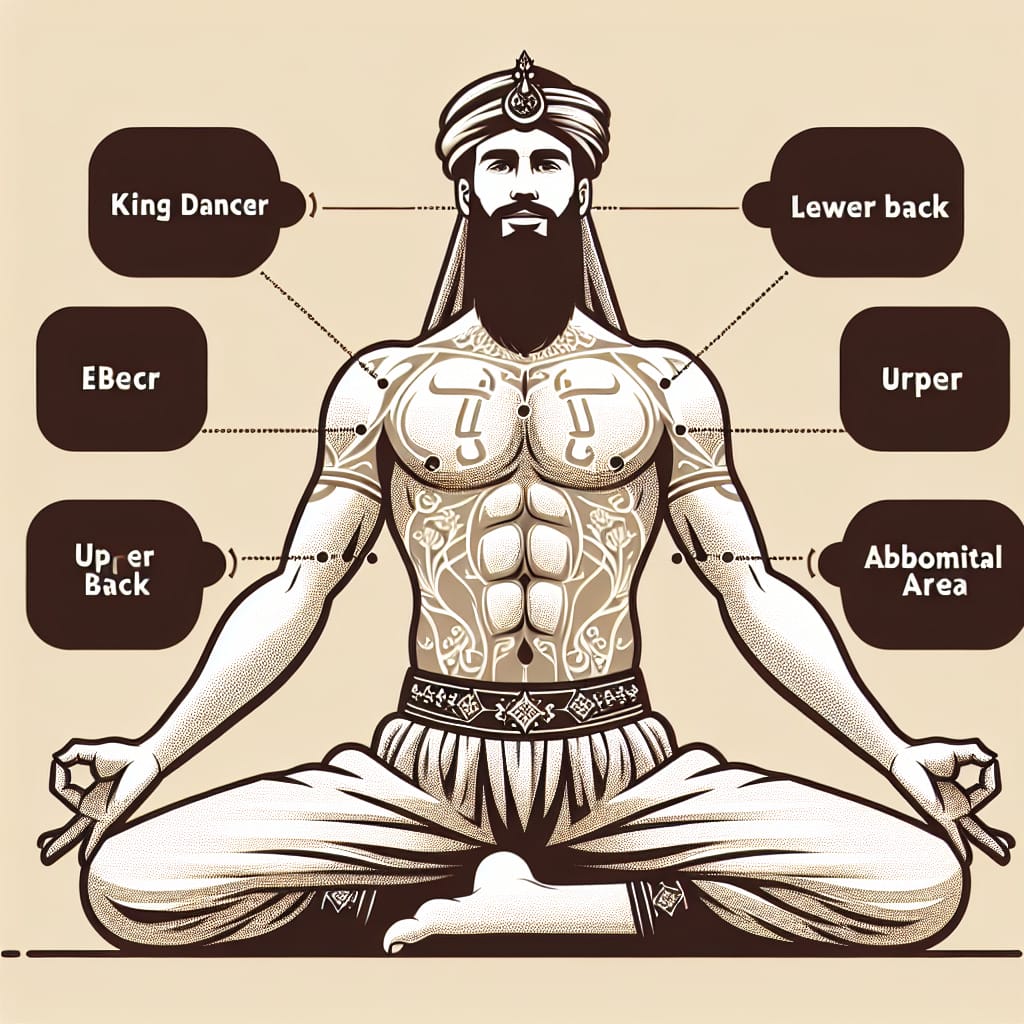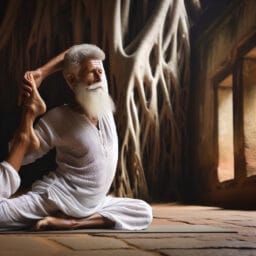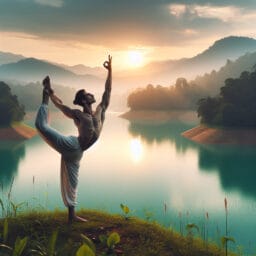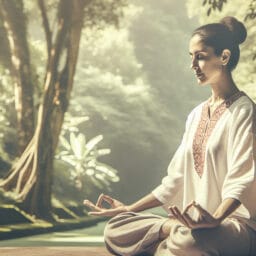
Mastering the King Dancer Pose: A Comprehensive Guide for Yoga Enthusiasts
Table of Contents
- Introduction: Unveiling the King Dancer Pose
- History and Origin: The Roots of the King Dancer Pose
- Benefits of the King Dancer Pose: Physical and Mental Gains
- Step-by-step Guide: Performing the King Dancer Pose
- Common Mistakes and Corrections: Perfecting the Pose
- Modifications and Variations: Adapting the Pose
- Contraindications: When to Avoid the Pose
- Conclusion: The King Dancer Pose in Your Yoga Routine
- Frequently Asked Questions
Introduction: Unveiling the King Dancer Pose
Within the multitude of yoga poses, the King Dancer Pose, also known as Natarajasana, stands out. This pose is symbolic of Lord Shiva’s dance, representing a cosmic cycle of creation and destruction. As graceful as it is powerful, the King Dancer Pose provides an extensive array of physical and mental benefits. It targets your lower back while helping to develop strength in your standing leg. Furthermore, this deep backbend can boost energy levels and engage your abdominal area. Your upper body gains from holding the posture too; with your body weight primarily on one foot, you’ll strengthen both legs while enhancing balance and concentration. The lift of the back leg high into a bend simultaneously opens up the hips and stretches middle to upper-back muscles; this advantageous shift in body alignment encourages proper posture off the mat too. Alongside meditation benefits like reducing stress and cultivating mindfulness, it’s clear why yoga teachers often include Natarajasana in their sequences – whether transitioning from mountain pose Tadasana or using it as a base pose for more advanced postures such as Vrksasana tree pose or Plank Pose/Adho Mukha Shvanasana.
History and Origin: The Roots of the King Dancer Pose
The King Dancer Pose, known as Natarajasana, is intimately linked to Lord Shiva, embodying his dynamic cosmic dance. Its history stretches back centuries, with variations evolving over time to suit yoga sequencing in diverse contexts. Known for developing strength and balance while engaging the standing leg, upper body and abdominal area, this pose is a staple in many yoga types. Keeping the spine straight encourages proper posture off the mat as you lift your leg high into a deep backbend. This position targets not just your lower back but extends benefits to your middle and upper back too. A mindful execution of this dancer pose can also act as meditation science demonstrates its power to boost energy levels and reduce stress. As such, it’s no surprise that many yoga teachers incorporate this graceful yet powerful dance pose in their sequences transitioning from mountain pose Tadasana or using it as a base pose for other postures like plank pose or Vrksasana tree pose.
Benefits of the King Dancer Pose: Physical and Mental Gains
There’s a striking definitive grace to the King Dancer Pose, or Natarajanasana, that belies its complexity. This yoga pose is more than just an elegant display; it offers a wealth of benefits for both body and mind. Physically, it challenges your strength and flexibility, demanding balance as you bear your body weight primarily on one leg while extending the other leg high in a deep backbend. As you achieve this balance, your lower back gets notably strengthened and your middle to upper back muscles get stretched – a combination that can aid in maintaining a spine straight even off the mat. In addition to giving legs and hips an intense workout, the abdominal area also gets engaged during this dance pose. On a mental level, performing Natarajasana can be akin to meditating through movement; as you focus on posture alignment and slow breathing coordination, there’s potential to reduce stress levels significantly and boost energy. The King Dancer Pose is therefore not just another entry in yoga sequences but serves as a holistic contribution benefitting various body parts while enhancing mindfulness – a testament to meditation science merged with physical conditioning.

| Benefits of the King Dancer Pose: Physical and Mental Gains | |
|---|---|
| Physical Benefits | Mental Benefits |
|
|
 |
|
Step-by-step Guide: Performing the King Dancer Pose
The King Dancer Pose, or Natarajasana, is a graceful display of balance and strength – a gem among yoga poses embodying the cosmic dance of Lord Shiva. While this elegant pose may seem complex at first glance, its benefits to both your mind and body are manifold. As you stand on one foot with your other leg high in a deep backbend, not only do you develop strength in your standing leg but also engage your lower back, middle back and upper body. The balancing act involved simultaneously helps maintain a straight spine while stretching the back muscles. Moreover, yoga teachers often use it as a transitional base pose – reinforcing yoga sequencing from mountain pose Tadasana or plank pose into more advanced positions. Through disciplined practice, the King Dancer Pose can turn into an invigorating physical meditation; boosting energy levels while reducing stress – proving that science and spirituality coalesce beautifully within this powerful dancer pose.
Common Mistakes and Corrections: Perfecting the Pose
A surprising fact about the King Dancer Pose is how it encompasses a myriad of benefits for its practitioners, while offering variations to suit different yoga types. When performed correctly, Natarajasana strengthens your lower back and standing leg, engages your abdominal area and upper body, improves balance with shifting body weight and promotes an upright spine by stretching the back muscles. A common mistake beginners make is not maintaining their feet close during this pose which can strain the lower leg. To avoid such mishaps, a good technique is to visualize keeping your legs hips-width apart while executing the deep backbend. It’s essential for yoga teachers to incorporate poses like Natarajasana into their yoga sequences holistically; whether transitioning from mountain pose Tadasana or plank pose Adho Mukha Shvanasana into more complex poses like Vrksasana tree pose. This approach not only develops strength but also boosts energy levels through mindful breathing – an excellent testament to meditation science blended with physical conditioning in benefitting from yoga poses.
Modifications and Variations: Adapting the Pose
A unique aspect of the King Dancer Pose, or Natarajasana, lies in its varied alterations that cater to diverse skill levels. Beginners may prefer a simpler variation, maintaining their body weight on the standing leg and stretching the upper body without indulging in a deep backbend. As proficiency develops, practitioners can advance into extending the leg high behind them, challenging their balance while engaging the lower back and abdominal area more intensely. These modifications not only help maintain a spine straight but also fortify middle to upper back muscles – hallmarks of benefitting from yoga poses like vrksasana tree pose. Yoga teachers emphasize these variations in yoga sequencing to ensure each practitioner finds their own comfort zone within this dance pose dedicated to Lord Shiva. The ability to customize this pose makes it a versatile addition to any yoga sequence, fostering development of strength regardless of one’s familiarity with the practice.
Conclusion: The King Dancer Pose in Your Yoga Routine
The King Dancer Pose, a dynamic and elegant yoga pose dedicated to Lord Shiva, embodies an intricate balance of strength, flexibility, and mindfulness. Embraced across varied yoga types for its profound meditation benefits, Natarajasana is a transformative posture that vigorously engages your standing leg as you lift the opposite leg high in a deep backbend. This unique alignment not only fortifies your lower back but also stimulates the abdominal area while promoting an upright spine. Yoga teachers often incorporate this pose into their sequences as it seamlessly transitions from mountain pose Tadasana or plank pose Adho Mukha Shvanasana into more complex poses like Vrksasana tree pose. With practice and patience, performing the King Dancer Pose aligns body weight distribution and enhances overall body strength – proving it’s more than just another entry in yoga sequences but a vital element to holistic wellbeing. As you navigate through various stages of this dancer pose, remember to keep your feet close together with legs hip-width apart to maintain balance; thus fully reaping the rewards of this captivating dance of cosmic creation and destruction.
Frequently Asked Questions
Q: What is the King Dancer Pose?
A: The King Dancer Pose is a significant yoga pose that focuses on strength and flexibility. It’s a powerful pose that can help various parts of the body, especially the lower back, upper back, and abdominal area.
Q: What’s the history of the King Dancer Pose?
A: The King Dancer Pose has its roots tied to Lord Shiva and has evolved tremendously over time, becoming a widely recognized and practiced yoga pose.
Q: What are the benefits of the King Dancer Pose?
A: The King Dancer Pose comes with several physical benefits such as improved strength and flexibility. Additionally, it offers mental benefits such as increased energy levels and meditation benefits.
Q: How can I perform the King Dancer Pose?
A: Detailed instructions to perform the pose are as follows: maintaining a straight spine and balanced body weight are crucial. Transition poses like mountain pose tadasana and plank pose are recommended before entering the King Dancer Pose.
Q: What mistakes should I avoid when performing the King Dancer Pose?
A: Some common mistakes beginners make include inadequate sequencing of yoga poses. To avoid these, focus on maintaining a straight spine and balanced body weight throughout the pose.
Q: Are there any variations of the King Dancer Pose?
A: Yes, there are several variations and modifications of the pose that cater to different skill levels. For instance, the Vrksasana or tree pose is a related pose.
Q: When should I avoid the King Dancer Pose?
A: Certain individuals should avoid the King Dancer Pose due to potential risks associated with it. Consulting your local yoga instructor or a healthcare provider before performing the pose is advised.
Q: How can I incorporate the King Dancer Pose into my yoga routine?
A: The King Dancer Pose can be incorporated into your yoga routine as it enhances both physical strength and mental focus. However, before starting any new yoga routine involving this pose, it’s advisable to consult with a professional yoga instructor.



